TURKEY BY SEA
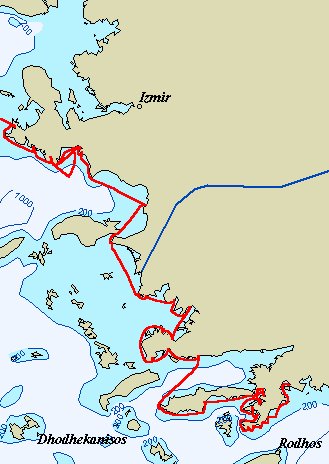
Turkey’s southern coast borders the Mediterranean Sea, its west coast borders the Aegean Sea, and its northern coast borders the Black Sea. We drove along part of the scenic southern coast, and we have decided against sailing there. We sailed the west coast in the Aegean Sea in 2011, and we headed northwest again in 2012.
The west coast is characterized by a series of bays within gulfs along a highly convoluted shoreline. We traveled south to north along what is called the Carian Coast and the Ionian Coast.
The Carian Coast stretches from Marmaris northward to Bodrum. This area was populated in the first millenium BC by indigenous Anatolians. The coast is mountainous and was somewhat isolated until recent decades. It is now popular and populated.
The Ionian coast stretches from above Bodrum northward to Cesme. This area was populated by Ionians in the 10th century BC, and it became a highly influential region in in Asia Minor. The Ionians included artists and scientists of the Hellenic period. Today’s coast is less mountainous, and it is quite fertile.
We started at the southwest corner of Turkey in Marmaris in the Mediterranean. We then followed the Carian coastline through the Gulfs of Yesilova, Hisaronu, and Gokova.
Marmaris to Serce Limani – 28 miles/5.5 hrs
This was a wet, windy, and bumpy start to our Mediterranean sailing, and we were not adequately prepared. We had not put up our plastics to keep the salt spray out of the cockpit. We had not put up our running backs although we were motorsailing in big winds with a single reefed main and staysail. But we did learn a few things:
1. The meltemi is real. It blew 25-30 knots on our nose all day.
2. It is good advice to be secured in your anchorage by 1300. That is about the time that the meltemi usually starts, and that gives you eight hours of remaining daylight to ‘Med moor’ your boat and clean up the mess.
3. Med mooring sucks. It is much more difficult than it looks.
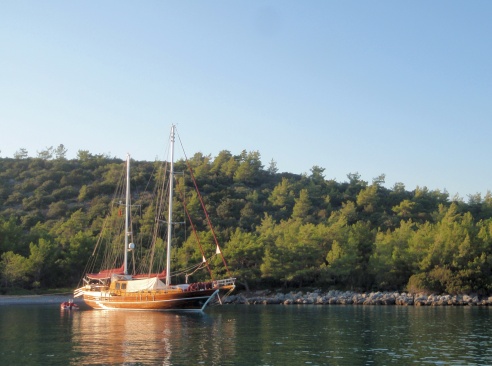
The ubiquitous gullet – in every anchorage
If you are Med mooring to the shore, it involves dropping your anchor at some distance off, backing toward shore, and tying a line or two ashore either around a rock or tree. If you are Med mooring to a dock, you must back in to a space – usually far narrower than your boat – and tie your stern to the shore or dock. You may have dropped an anchor ahead of your bow, or some docks will have lines tailed to the dock. Regardless, Passage does not back well (skeg-hung rudder, Max Prop, etc.), and we are not experienced at backing her. Being a cruising boat, we have lots of ‘stuff’ on our stern and aft deck, and it is not easy moving about back there. We recognized a challenging learning curve ahead of us.
But Serce Limani was a beautiful and well-protected harbor. It was occasionally a bit gusty, but we held very well. The water was clear, and there were wild donkeys and goats on the hillsides all around us. We had a spectacular full moon rise.
It was great to be sailing again. We stayed for two nights.
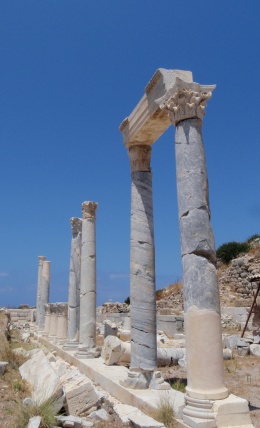
Columns at Knidos
This was just a 4 ½ mile motor. We had read about some interesting ruins at the entrance to this harbor, and we wanted to explore them.
Just inside the harbor is the Ali Baba Restaurant and dock. It is common in Turkey for small restaurants to build some type of dock to which visiting boats can tie. They usually do not charge for docking, but you are expected to have dinner in their restaurant. Seems fair, so we gave it a try. We did not embarrass ourselves too badly as we moored to their dock.
As the day went on, the little dock became very noisy and crowded. We were quite surprised at the number of boats they packed in. But Passage was secure, so we went hiking.
Some interesting ancient trivia… This harbor was a harbor of refuge in ancient times, and it was sometimes used to assemble naval fleets. It was used by Demetrius Polioketes around 400 BC to construct a huge catapult machine for attack on Rhodes. The Rhodes attack failed, and Polioketes sold his catapult. He gave the proceeds to the Rhodians, and those funds were used to build the huge bronze statue of Helios which was one of the seven wonders of the ancient world.
More recently, in Byzantine times, a huge citadel was built on the point, and much of it remains. Some of the blocks are more than 3 feet by 17 feet, and they have survived the centuries without mortar. The citadel remains were interesting, and the views to Rhodes were lovely.
We left Bozuk Buku early in the morning to get around a point before the winds or seas developed. We spent four hours leisurely covering 20 miles. We did some motorsailing and some slow sailing in light winds. We arrived in Sogut Limani with plans to spend a day or two there, but we were enjoying the sailing, so we kept going.
As expected, we found Bozburun a bit busy. We Med moored (a bit more smoothly than before, but we still need to work on this) about one mile south of town in a narrow pass between the peninsular shore and a small island – Yesil Adasi (‘adasi’ means island). There were ruins on Yesil Adasi, but we did not explore them. We had boat chores to do, so we stayed on board until the following morning.
The next morning was Tuesday, and that is Bozburun’s weekly market. It was around noon before we got there, and many of the vendors were packing up to leave. It is a small market, but we always enjoy the local culture at the markets.

Small theater at Knidos
We had lunch in town and bought some fresh fruits and vegetables. We spent only one more night, then we headed on.
We had very light winds – usually one to four knots – and no seas during this trip. We motorsailed with the main.
We had planned to stop at Selimiye, but we found it too developed for our taste. So we went on to Keci Buku – the small bay in which Marti Marina is located.
We explored the entire bay, and we were called toward a restaurant dock. We had not enjoyed our restaurant dock experience a few nights earlier at Bozuk Buku, so we did not stop. We anchored between the peninsular shore and a small islet without shore tying. We loved it! The boat settled bow to the wind so we had some ventilation, and the boat motion was familiar and comfortable. We don’t like Med mooring.
We had very little wind, and it was miserably hot. The little islet had Byzantine ruins on it, but we did not explore it. We did, however, take the dinghy up to the end of the bay and explore the small stores and restaurants there. We had lunch at the restaurant that had tried to wave us in – Luna Begonvil – and we were pleasantly surprised at the very good quality of their food, service, and docks. We were sorry that we had not docked Passage there, but the weekend was approaching, and they now had no space for us. We would definitely return there.
We took the dinghy to Marti Marina to check on the availability of diesel, and the impeller in our smaller (2 hp) outboard failed. We could not get a replacement anywhere in the marina, so we changed outboards from the ‘little sipper’ to the ‘big gulper’. We would have to burn a bit more of that precious gasoline for which we paid the equivalent of $11.90 per gallon. And we would need to find an impeller for the ‘little sipper’.
The winds picked up considerably, so we chose to spend a few more nights in this lovely anchorage before moving on. And when they moderated, we moved on.
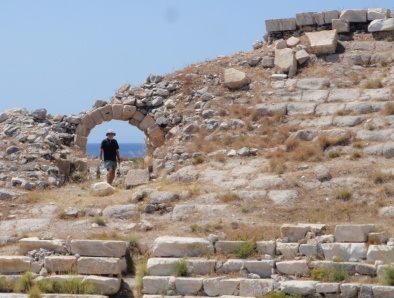
Entrance to small theater at Knidos
Before leaving the bay, we went to Marti Marina to take on some diesel (we had been doing a lot of motoring). Diesel cost 3.75 TL per liter – the equivalent of $8.37 USD per gallon.
We spent six hours traveling the 27 miles to Datca harbor, and we actually had enough wind to sail part of the way. We had very dirty decks, and Nita wanted to go inside the harbor to get access to fresh water. In retrospect, we should have lived with our dirty decks.
When we got in the harbor it was a bit gusty for us to Med moor, but try we must. It wasn’t pretty, but we got backed in to a space. Our anchor did not hold. So we had to go out and try again. Our second attempt was less graceful. But we finally got in with far too much anchor chain laid across the small harbor. And Nita got to wash the decks.We enjoyed the town of Datca. It was at least marginally less touristy than other places we had been. We had dinner at a local lokanta, and it was ok at best. It was too oily, and it lacked the freshness that characterizes Turkish food in the summer months. And the waterfront and our neighbors were both noisy that night, so we were a bit less charmed with the place as the night wore on. We were charged 47 Turkish Lira to stay overnight.
We wanted to leave in the morning, but two other boats had laid their anchor chain across ours (we were certainly partly to blame because we had laid far too much chain). One was a gullet, and that boat left around 0930. The other boat was a stink pot right next to us, and they seemed disinterested that they had us trapped in the harbor. Finally, with the dockmaster’s help, we raised as much chain as we could. Then the dockmaster jumped in the water (borrowed mask and fins from us) and helped us raise our neighbor’s chain on our anchor, lift his chain off our anchor, and get free. We did not get out of the harbor until 1100.
It took us four hours to motor the 21 miles to Knidos. There were many gullets anchored and Med moored, a few boats at anchor, and about six boats tied to the restaurant’s small dock. It was a bit chaotic, but we picked a spot and anchored.
Knidos is at the tip of the peninsula, and ancient ships often had to wait in this harbor for the winds to abate before rounding Cape Crio. The city of Knidos developed around 360 BC to accommodate this shipping traffic. There has been no further development around the harbor other than one small seasonal restaurant, and many of the remains of that city have survived: city walls, two theaters, several temples, agora, acropolis on the bluff. We spent a very hot day exploring the ruins.
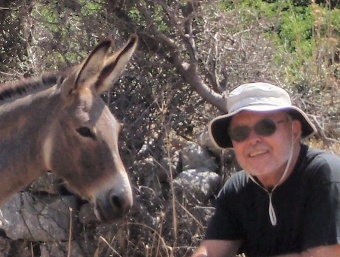
Braying wild ass
We again, as in Serce Limani, found wild donkeys and goats. There were also a few donkeys tied up that were approachable.
We had dinner at the only restaurant in the harbor, and it was quite pricey. The salads and side dishes are affordable, but the fish prices are outrageous!
In the morning, a gullet picked up our chain as they retrieved their anchor, and they dragged us around the harbor a bit. At one point, we had fenders and crew holding our hulls apart. But this is such a common occurrence that the locals have a name for it – anchor salad – and the crews know how to handle it (as we had just learned in Datca), and they went on their way. We had to reset our anchor. We enjoyed a second night at anchor, then it was time to move on while the winds allowed.
We traveled 27 miles in 5 ½ hours across the Gulf of Gokova to Alakisla Bay on the south side of the Bodrum peninsula. We anchored and took a long line to shore – not nearly as messy as some of our prior attempts. We felt secure.
This bay is about eleven miles east of Bodrum. It is a pretty bay that is wooded down to the water and undeveloped. Because of its proximity to Bodrum, many day-trip gullets come in during the day, and many multi-day gullets make this their first night’s stop out of Bodrum. But the bay is big enough that there was usually enough space to avoid feeling terribly over crowded. And the water was clean enough that Bud went swimming every day.
We enjoyed this bay enough that we stayed for three nights. This was a nice stop.
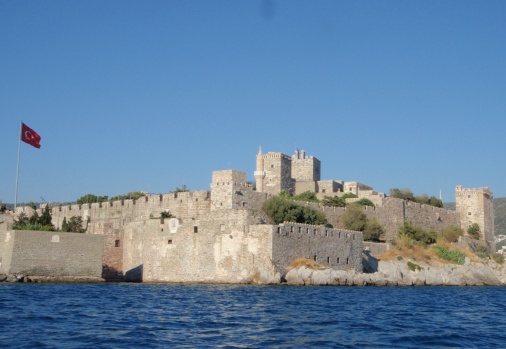
St. Peter’s castle
Our move to Bodrum was only 13 miles, and it took us less than three hours. We anchored just off St. Peter’s castle – our first castle – and looked forward to getting a few things done in the town.
The anchorage was miserable. Countless boats race around at high speed creating wakes that cause endless rolling. But the intolerable aspect of the anchorage was the noise. We know about ‘bar streets’ that play loud music till the wee hours, but Bodrum brought bar noise to a new low. They have party boats that motor around the anchorage until 5:00 am. The noise was unbelievable. And there was a race fleet in the marina, so we could not move inside. Certainly on our list of dreadful anchorages – one of the worst ever.
And we were not overly charmed by the town. It was very crowded. Not our kind of place.
But we had things that needed doing. The most important was getting a replacement impeller for our ‘little sipper’ outboard, and we did that.
We also had one thing that we wanted to do – visit St. Peter’s castle which is now a museum of underwater archeology. We did that.
Today’s Bodrum is the ancient city of Halicarnassus which was built in the 4th century BC. It claims a few noteworthy sons. Herodotus, the father of written history, was born there in 484 BC. Also, Dionysius, the great teacher, was born there in the 1st century BC. But the castle, which was not built until the 15th century AD, is the draw to Bodrum.
St. Peter’s Castle – This castle was built by the Knights of St. John – one of the military orders of the crusading armies. Although the crusaders wreaked havoc through much of Mediterranean Turkey, the castle of St. Peter is possibly their most prominent remaining symbol. The castle has five towers representing the nationalities of its crusading inhabitants – French, German, English, Italian, and Spanish.
The Ottoman Emperor, Suleyman the Magnificent, conquered Rhodes in 1523, and Bodrum came under Ottoman control at the same time. The castle was neglected for centuries, and it was used as a prison in the late 19th century. It was damaged during World War I, and it was used for storage during the 1960s. But its recent restoration is beautiful.
And the museum of underwater archeology housed within was interesting. Huge amounts of artifacts have been found in the waters surrounding the Turkish coast, and this museum organizes and displays many of them.
But we could not tolerate any more of Bodrum. We headed further west.
The weather forecasters accurately predicted increasing winds, but we went anyways. We motored nine miles west in just over two hours. Winds were steady in the low 20s by the time we arrived, but we were relieved just to be out of Bodrum.
Karaincir is a small bay with little of interest. The hills surrounding it are dry, and there is one small beach club on the coast. We got our anchor well set and waited out the winds which blew in the mid-twenties all day and gusted to 30. Not too bad.
We then went around in to the Gulluk Gulf and the beginning of the Ionian coast. This coast would include the Gulluk Gulf, Kusadasi Gulf, and Sigacik Gulf.
We left early to get around the point before the winds and seas built. We had 14 to 18 knots of wind, but the seas were calm. We rounded the point without incident. It took us six hours to travel 20 miles, but we made a detour along the way.
We headed to Turk Buku, but this was definitely not our kind of place. Apparently this is a vacation playground for some of the very well off Turks, and it looked a bit like Disneyland to us. This is the most mega power yachts we have yet encountered. All shapes and sizes and colors – even a bright orange one! We motored through and looked in amazement, then we moved on.

Small theater at Iassus
We went to Torba – just a few miles further in the gulf. Torba is also a resort town catering primarily to Turkish tourists, but it is much more low key. We walked around the village and ate some local foods that we had not previously tried, and we found a small grocery store where we added a few provisions to our dwindling larders.
Unfortunately, Torba, too, plays music in its clubs until the wee hours of the morning. However, it was nothing like the assaulting noise of Bodrum, and we did get some sleep – even if not quite enough. We moved on after two nights.
This was a short trip up to the far eastern end of the gulf. We traveled only 14 miles in just under three hours.
The most interesting part of this trip was the fish farms we saw along the way. We were aware that there is fish farming around here, but we were not expecting the size and sophistication of these farms. We still don’t know what they are farming. The best part of this trip was that we actually sailed for part of it. We are both very tired of motoring.
We passed the small commercial port of Gulluk to enter the quaint bay of Asin Limani. This is the site of a small fishing village with a concrete quay to which visiting boats can moor (yes, Med moor). We were charged 30 TRY per night. It still wasn’t pretty, but we got in and tied up without overly embarrassing ourselves.
The draw to Asin Limani is the ancient ruins of Iassus. We visited the ruins, and we enjoyed them, but we were also totally charmed with the small village there – Kurin.
Iassus dates back to the 2nd millennium BC, and it has been occupied by various groups throughout the centuries. Most of the remains still standing date to the 4th century BC. Those remains include a surrounding wall, temple, tower, theater, and agora. When we explored Iassus, there was no one there other than us and a few caretakers whacking weeds. After exploring the ruins we walked through an ancient olive grove. It was easy to transport our minds back in time and imagine it as it had been in times past.
The small village of Kurin is built on top of part of ancient Iassus, and we really liked it. It appears economically depressed, but the people seem upbeat. There is very little English spoken, but the people are friendly.
We met a lovely young French couple on a charter boat next to us, and we sat on the quay sipping raki till midnight. We ate excellent food at reasonable prices. And we just walked around enjoying the ambiance of this little village. This is the first place we have been that we both really enjoyed. We are finally away from the nightclubs of the cities to the south, and we feel like we are finally in the ‘real’ Turkey. We hope to find more places like this.

Lassus columns and ruins
It took us less than three hours to travel the 13 miles to Paradise Bay. We sailed only briefly. It was mostly motoring – as usual. We would have made better time, but we had to dodge numerous fish farms. They are everywhere!
This unnamed bay has been christened ‘Paradise Bay’ by prior cruisers passing through. There are probably many bays sharing this nickname, but this one deserves its name. It is a small bay that is heavily wooded down to the water with a few trails among the trees (we saw a horse and rider on one) and one currently unused fish camp. It is shallow, and the water is clear. Very pretty.
When we arrived, we were the only boat in the bay, and we were thrilled to have it to ourselves – even if only temporarily. Shortly thereafter, a large boat came in and anchored so close to us that we moved our anchor (bad manners). We ended up doing the dreaded shore tie, and it wasn’t pretty. But we were secure for two peaceful days and nights as other boats came and went. Bud really enjoyed swimming there.
The weather forecasters were predicting winds in the high 20s and gusting to the low 30s for the next few days, so we decided to move to a marina. The marina would provide some protection from the wind (hopefully), it would enable us to travel to town to tend to a little business, and it would give us a fresh water source to do some badly needed cleaning. So we headed off to D-Didim Marina for a few nights.
We have been using windguru.com for our weather predictions, and it has been remarkably accurate. Just as predicted, the winds piped up in the morning of the 11th, they built throughout the morning, and it blew like stink by the evening. Fortunately we had the good sense to get up and going early, but we still had winds in the low 20s with choppy seas. However, Passage, again acting like an old dog with a bone in her teeth, took it in stride. We had a double reef in the main and the staysail, and we covered the 11 miles in less than two hours.
D-Didim is just another marina. It has a few good features, and it has some annoying ones. But we thought it wise to hide out there while the winds blew through, and we could get a few things done.
We explored a bit around Didim, and it seemed a somewhat dreary town. However, the marina was new and the facilities were nice. We spent a nice evening on board a neighbor’s boat – JAD – with two couples we met there. The owners of JAD are Belgian and Portuguese, and another couple was American and Turkish. Our ‘cocktail hour’ lasted until 11:00 pm. That reflects the pleasure of the evening.
We again waited out some winds while in the marina, then we moved on.
We wanted to round Tekagac Point and head for Kusadasi, and we knew we needed to start that leg early in the morning. So, when we left Didim Marina at 10:30 local time, we went only five miles to Cukurcuk – an anchorage just southeast of the point.
There were two fingers to this bay, and there was one sailboat anchored in each. We did not get a good bite when we dropped our anchor in the western finger, so we moved to the eastern finger and got a bite. Our winds changed by 180° during the night, but we held well.
It was an enjoyable quiet night. There was no shore noise at all. We left early in the morning towards Kusadasi – still two days away.
We spent four hours moving another 21 miles north toward Kusadasi. The winds were very light when we left, but they were steady around 20 by the time we were approaching Samos Strait where the Greek island of Samos is less than one mile off the Turkish coast. The wind usually intensifies as it funnels through the strait, and strong currents are common, so we decided to leave the strait for the next morning, and we pulled in to Port St. Nikolao.
There were two large catamarans in the anchorage when we arrived, but they both left shortly thereafter. Bud went swimming and discovered that the water was noticeably cooler than a few miles further south. We explored in the dinghy and noticed many ruins along the shore, but we don’t know what they are. Then we settled in for the night.
During the evening, three small local fishing boats came in and rafted up together. And later, after dark, a slightly larger fishing boat came in and joined them. We enjoy hanging out with the local boats.
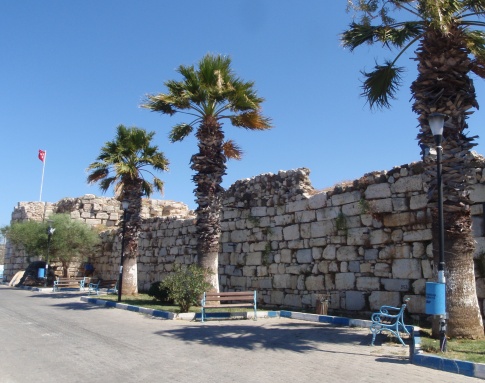
Outside castle wall at Teos
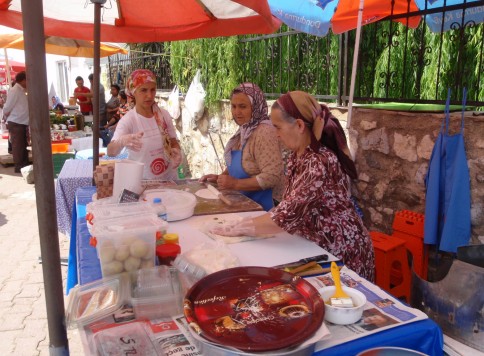
Our favorite food stall at Sigacik market
We were off early in the morning to get through Samos Strait before the winds kicked up, and we were through the strait just over an hour after we left. Shortly thereafter we had enough wind to sail for a while – yippee!! But it did not last, and we motorsailed on up to Kusadasi Marina. We spent almost five hours traveling 21 miles.
We wanted to check out Kusadasi Marina as a possible place for us to spend the upcoming winter. We arrived in the Med with plans for how we would spend the next few years, but they have changed considerably since we arrived – and they continue to change. But we have decided that we would like to winter as far north as we can bear, and that is probably Kusadasi.
The town of Kusadasi was ok. It is much less ‘touristy’ than further south. They have a great market, and we ate some good food (the food is good everywhere in Turkey!). The marina was a mixed bag. We liked that it is not so crowded and crazy as marinas further south. But the marina itself is a bit rough. Although we would stop again if we were passing by, this is not where we want to be for the winter. Onward…
We decided that we would go as far north as Cesma with a stop at Teos along the way. The weather reports were good, and we left early, and we had a miserable day.
By the time we reached Doganhey Point – less than four hours after leaving – the winds were steady in the high 20s and gusting in the low 30s. We handled the winds ok, but the seas were very choppy and growing. We pushed on, and the winds were soon steady in the low-mid 30s, and the seas were even more unpleasant. We were not having any fun, so we pulled in to the only known anchorage along the way – Seferihisar.
Seferihisar is a shallow anchorage than was covered in white caps. Our first anchor drop did not hold, and when we raised the anchor, it was not visible within the mass of sea grass that had enveloped it. We removed the grass and moved to another spot hoping for some sand. We got a good bite in 19’ of water.
It had taken us almost seven hours to travel 32 miles, and about 25 of those miles had been somewhat miserable. We are not enjoying sailing in the Med.
The winds were down early in our second morning at Seferihisar, so we decided to make a break for it. As soon as we got outside the bay, we faced increasing winds and choppy seas again. The winds were in the low 20s and gusting to 30, and the seas were short, choppy, and uncomfortable. But we only had a few miles to go, so we pressed on.
We motored 6 miles in just over an hour, and we found conditions slightly improved as we approached Teos Marina. Fortunately the marina is well staffed, and they helped us get settled. The winds blew in the mid-20s and gusted in the mid-30s for two days.
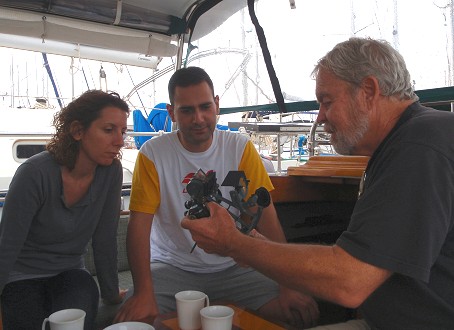
Bud explaining sextant to Ozlem and Tunc
Teos is the site of some ancient ruins that we did not visit, but it is also the site of an old walled village called Sigacik that we did visit. This village is built within stone walls that were once the walls of an Ottoman castle. The castle was built in the 16th century, and little of it remains. However, most of the outer walls remain, and they enclose the quaint village of Sigacik. A walk through the village seems like stepping back in time until a satellite tv dish is seen on a roof top. There are some incongruous contrasts, but it does appear to be a highly traditional village from another era.
Teos grew on us quickly, and we decided we really like it. Its charm is its frustration. There is little to do off the boat – no shopping, entertainment, very few places to eat. Even if there was more to do, it would be difficult to accomplish much because almost no English is spoken. So although it can be frustrating, it also feels very much like rural Turkey rather than another holiday village. We like it.
Although we like it, we did not want to spend the winter here. We have decided against spending the winter in the Med. So we took Passage out of the water, and we headed for warmer climes. We will begin our next season here in the spring.
So here is where we will end our 2011 season – and what a season it has been. Next season? We have a few ideas, and we will distill them a bit over the winter. But for now, we are off to get warm…
After six months in the yard over the winter, we launched Passage on April 29. Our friends Tunc and Ozlem jumped on board with us, and we went for a quick motor around the bay to determine that nothing was leaking. Nothing was, so we took her to her slip to start the clean up.
Kirkdilim Limani is a deep bay with a hook to the west at the upper end that provides good shelter in most conditions. There is no development at all, and there was one other boat there. We anchored a mannerly distance away in 14 feet. We had a peaceful and quiet night.
The wind was less cooperative on our return sail the next day. We traveled 15 miles in 3 hours. It was dead down wind, but it was too light to sail. So we motorsailed back to the marina. We stopped at the fuel dock and filled our diesel tanks (we have learned to take advantage of quiet times) at the equivalent of $8.51 per gallon. We had discovered only a few minor issues that needed attention before leaving to start our cruising season.
We had started rolling a bit during the night, and the bay had become untenable by morning with increasing winds and steep swell rolling in. We had to leave.
Our windlass, a truly beautiful piece of machinery, had its first hiccup ever. We could not get the anchor up, and we were drifting toward rocks close behind us. Bud held us off with the engine while Nita figured out how to get the anchor up, and we headed out. But that was just the beginning of a miserable day.
The winds and seas continued to build. The winds were in the high 20s and were manageable, but the 6’ seas became problematic. At different times both of our rails were buried, and our decks were awash. Salt water was everywhere. It was like a washing machine. But there was no option but to carry on to another anchorage – hopefully a safer and more comfortable one.
We pulled in to Mersin Korfezi only 11 miles away and 2 ½ hours later, but it seemed like a few days. This bay has a small island near the entrance, and we ducked behind it. It has a few non-descript fishing camps on the mainland shore, but it looked like paradise to us. The winds continued to blow over the island at 15 to 20, but the seas were merely a bit bumpy – not completely comfortable, but not dangerous. Fortunately the anchor went down without any problem, and we repaired the windlass and cleaned up the boat. The wind continued to blow, so we stayed tucked in behind the island for a few days.
On the night of the 17th – our third night there – a dramatic cold front blew over us with strong gale force winds. We had thunder, lightening, and 44 knots of wind behind our ‘protective’ island. That is the equivalent of more than 50 miles or 80 kilometers per hour – Beaufort force 9. We had no way to know how much wind was blowing outside, but there was too much inside.
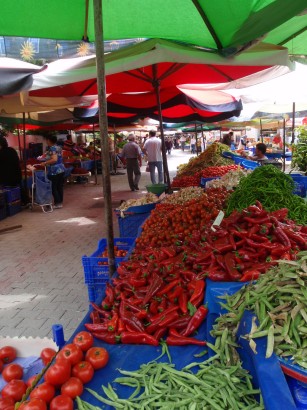
Produce market in Cesme
20 miles in 3 ½ hours
By mid-morning there was a respite in the wind, so we took the opportunity to move on to a more protected place. We could see squalls around us, and we watched approaching rain on radar, but we had calm wind and nearly flat seas. We motored on to Cesme Marina.
Cesme is an interesting town. It is a weekend get-away spot for many Turks living in Izmir.
The waterfront is dominated by a 16th century Genoese fortress that houses the Cesme Museum. A few blocks inland is the Orthodox Church of the Haralambos which is no longer used as a church. Otherwise, the town is mostly shops, hotels, and restaurants. We ate at a few of the restaurants – all excellent – and shopped a bit for basic provisions.
The highlight of our time is Cesme was rug shopping. There is only one rug shop in town, so there is no price competition, and prices are shocking. We found a few rugs we really liked, but they were way beyond our budget. We looked and admired, but we did not buy.
On May 25, we finally left Turkey with heavy hearts. We love Turkey – the people, culture, food, landscape, etc. We will miss it, but we will return another time. For now, we must move on. We sailed to Greece on May 25, 2012.
Follow us to Greece or jump to our sailing in Greece page or return to our Turkey page or our sailing page.